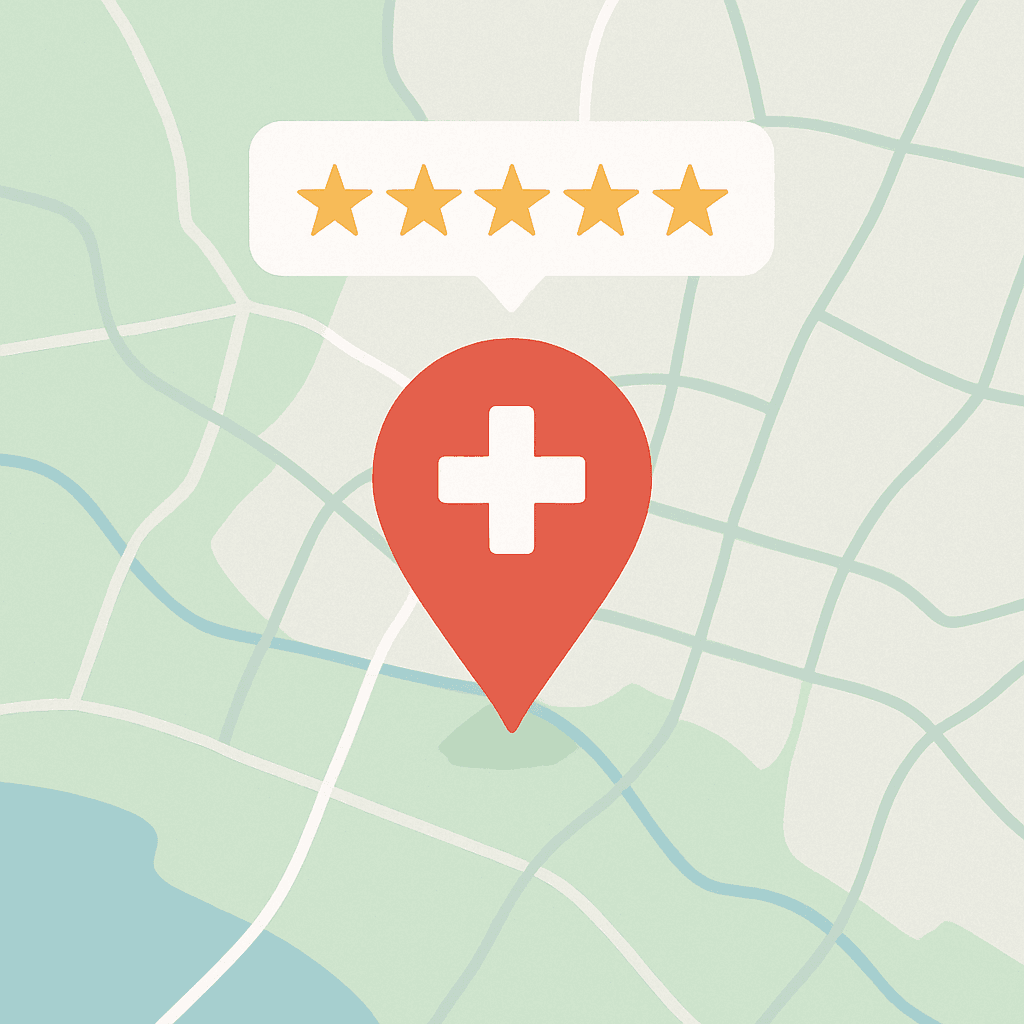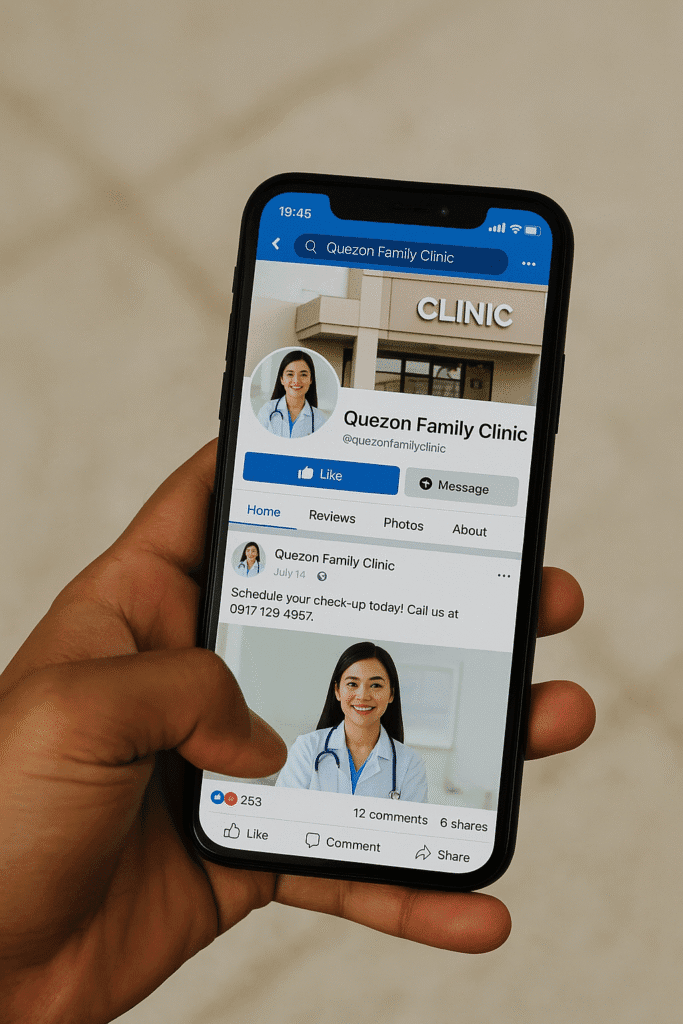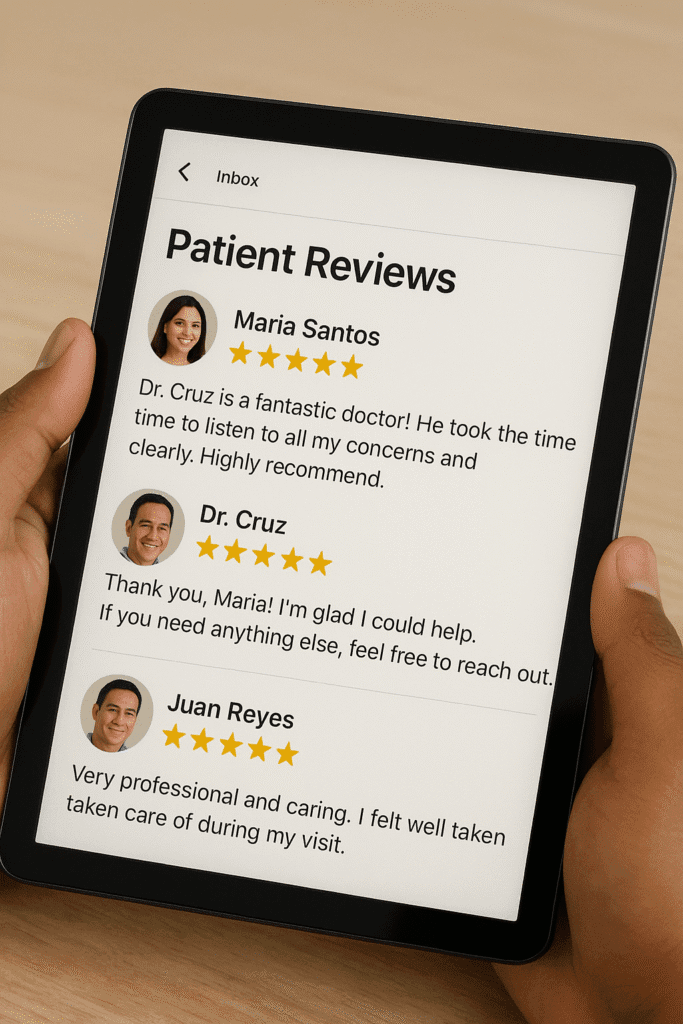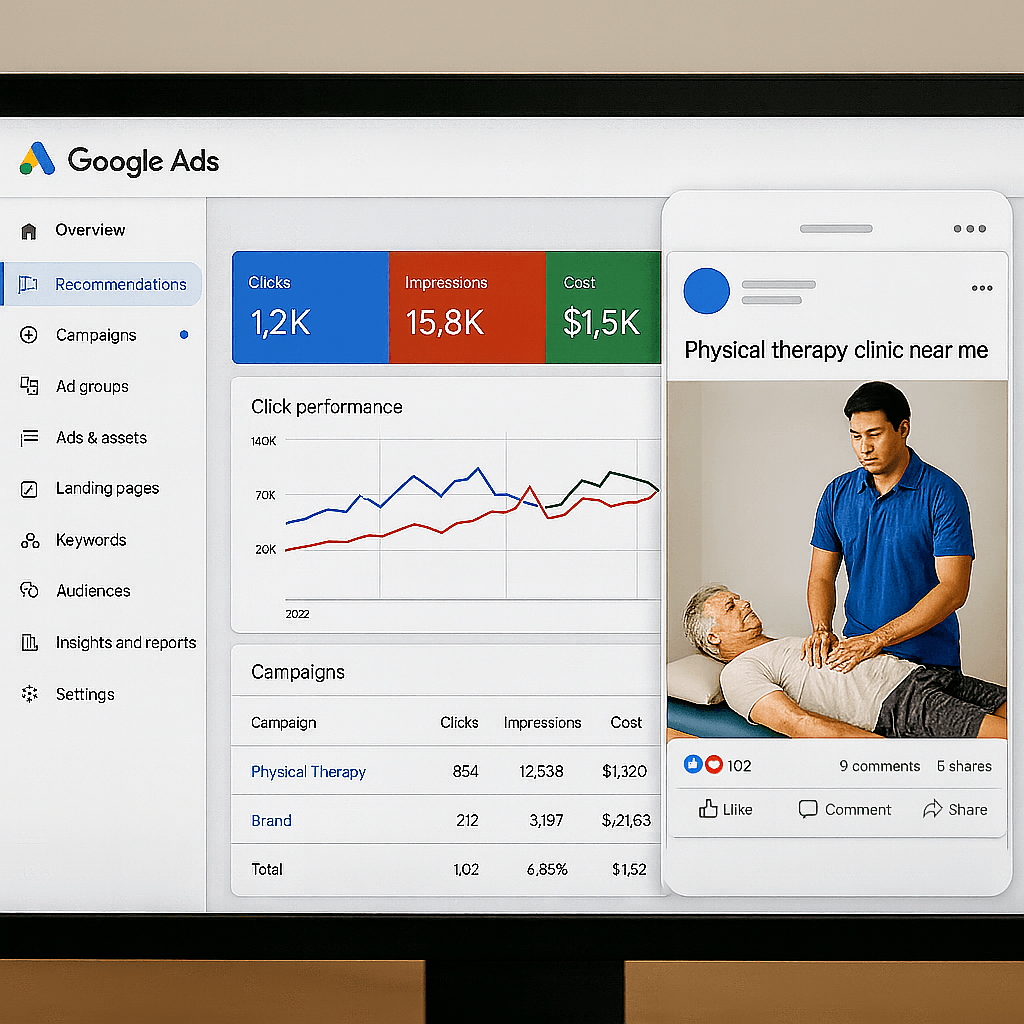Turn your website, search engines, and social media into powerful magnets for new patients.

In today’s digital age, building a strong clinic online presence is essential for clinics of all types—from dental and dermatology practices to general healthcare and wellness centers.
The majority of healthcare consumers now begin their journey by finding and comparing providers online. In fact, most patients look up symptoms, read patient reviews, and compare doctors on the internet before ever making an appointment. If your clinic’s online presence is lacking, you risk being overlooked. One industry survey found that 63% of people chose a healthcare provider based on who had a stronger online presence. The good news is that by taking strategic steps, you can significantly boost your clinic’s visibility, credibility, and patient engagement online. This in-depth guide covers everything from your website and SEO to social media and online reputation – all the key ingredients for a professional but friendly digital presence that attracts and retains patients.
Not long ago, having a basic website might have been enough, but today a successful online presence requires multiple channels working together. Platforms like your website and blog, social media networks, email newsletters, and online directories all contribute to a collective digital footprint that makes your clinic more visible and accessible to patients. By integrating these elements with consistent branding, you create a robust presence that is greater than the sum of its parts. A strong online presence becomes your new “digital front door,” guiding more patients to your clinic and building trust even before they walk in.
Build a Patient-Friendly Website to Strengthen Your Clinic Online Presence
Your website is the cornerstone of your clinic online presence, shaping first impressions and setting the tone for patient relationships. It needs to instill confidence and be easy to use. Research shows that 75% of users judge a company’s credibility based on its website design alone – an outdated or confusing site can drive prospective patients away. To build trust from the moment a visitor lands on your homepage, ensure your site looks professional, loads fast, and is intuitive to navigate. A clean, modern design with welcoming visuals signals professionalism and compassion, qualities patients seek when choosing a provider.
Equally important, your website must be mobile-friendly. More and more people use smartphones to search for healthcare information on the go. Google prioritizes mobile-friendly sites in search rankings, and offering a seamless mobile experience will improve both your visibility and user engagement. If a patient has to pinch, zoom, or wait too long for pages to load on their phone, they’ll likely move on to another provider’s site. Use responsive web design that adapts to all screen sizes, and optimize for fast loading speeds to keep visitors on your site.
Include all essential information that patients might look for. At minimum, your website should clearly display: who you are (about the doctor(s) and care team), what services you offer, where you are located (office address with a map) and your hours, and how to get in touch or schedule an appointment. Consider adding online appointment booking to streamline the process for new patients. It’s also wise to feature patient testimonials or reviews on your site and an educational blog with health tips or FAQs – these elements not only help patients learn about your practice but also demonstrate your expertise. Your website essentially acts as a digital storefront open 24/7, so make it as welcoming and informative as possible to encourage visitors to become patients.

Optimize for SEO to Boost Your Clinic Online Presence

Optimizing for search engines is one of the most effective ways to grow your clinic online presence and appear when patients search for care.
Even a beautiful website won’t help your clinic if no one can find it. This is where Search Engine Optimization (SEO) comes in. SEO is the backbone of online visibility, helping your site rank higher on Google and other search engines for relevant queries. When someone searches for “[specialty] clinic near me” or a health question related to your services, you want your clinic to appear at the top of the results. Search engines drive far more traffic to healthcare websites than any other source – studies show search brings 3× more visitors to hospital sites compared to non-search channels. In most medical fields, over 60% of consumers run a search before scheduling an appointment, so optimizing your site for search is crucial.
Start with on-page SEO fundamentals. Identify the keywords patients might use (for example, “pediatrician in [Your City]” or “best dermatologist near me”) and incorporate them naturally into your site’s page titles, headings, and content. Each service or treatment you offer could have its own page with relevant keywords and informative content. Publishing high-quality content on topics your patients care about will not only help your SEO but also showcase your expertise (more on content strategy in a moment). Additionally, ensure your site’s technical SEO is solid: improve page load speeds, fix any broken links, and make sure the site is secured with HTTPS encryption. A technically sound website makes it easier for search engines to crawl and index your pages.
Don’t forget about what Google calls E-E-A-T: Experience, Expertise, Authority, and Trustworthiness. Especially for healthcare websites, Google’s algorithms favor content that demonstrates professional expertise and credibility. To boost your E-E-A-T, highlight the experience and qualifications of your doctors, include authoritative references in your blog content, and make sure your site has clear contact information and trust signals (such as badges, certifications, or associations). Earning backlinks from reputable healthcare websites (for instance, a local hospital or a professional association linking to your site) can also improve your authority in Google’s eyes. In short, SEO ensures that when patients search online for the services you provide, they can find you easily – which directly translates into more appointments.
Maximize Local SEO with Google Business Profile & Directories
For any clinic or healthcare practice, local visibility is paramount. When someone in your area searches for a doctor or clinic, you want to be prominently featured. One of the most effective tools for this is Google Business Profile (formerly Google My Business). Claim and optimize your Google Business listing as soon as possible. This free profile allows your clinic to show up on Google Maps and the local 3-pack of search results, complete with your address, phone number, hours, and patient reviews. Make sure all of your information is accurate and up to date – consistency is key (your clinic name, address, and phone number should match exactly what’s on your website and other listings). Add photos of your clinic and staff to make the profile more engaging, and select appropriate categories for your services. A well-optimized Google profile significantly increases your chances of appearing in local searches for clinics in your specialty.
Beyond Google, consider other online directories and listings that patients use. These might include healthcare-specific directories (like Healthgrades, ZocDoc, WebMD or insurance provider directories) as well as general review sites (Yelp, Facebook, etc.). Search engines give weight to these listings too – they help signal that your business is legitimate and locally relevant. Audit your presence on all major directories and ensure your details are correct across the board. This includes small details like abbreviations in your address; even minor inconsistencies can hurt your local SEO. If your clinic has multiple locations, create a separate listing for each with the appropriate local info.
Encourage patients to leave reviews on your Google profile and other platforms (more on managing reviews in a later section). Positive reviews boost your visibility in local search results and make your listing stand out. According to a BrightLocal survey, 81% of people use Google reviews to evaluate local businesses – making Google by far the most used review platform (the next was Facebook at 45%). In summary, focus on being everywhere patients are searching locally: claim your Google Business Profile, optimize it with complete info and photos, get listed in reputable directories, and keep all profiles consistent and up-to-date. This multi-pronged local SEO approach will help nearby patients discover your clinic first when they need care.Claiming and optimizing your Google Business Profile is a critical step in strengthening your clinic online presence within your community.

Engage Patients on Social Media

Social media isn’t just for retailers or restaurants – it has become an indispensable channel for healthcare communication as well. An active social media strategy not only engages patients but also expands your clinic online presence far beyond your website.
Nearly 90% of Americans now use social media for health information and support, marking a dramatic shift in how people seek healthcare knowledge. Platforms like Facebook, Instagram, and LinkedIn offer your clinic an opportunity to connect with patients in a more personal, interactive way. By maintaining an active social media presence, you can build a sense of community and trust around your practice.
To get started, choose the platforms that make sense for your audience. Facebook is widely used across demographics and is great for sharing clinic updates, health tips, patient testimonials (with permission), and even running targeted ads or community polls. Instagram can humanize your clinic by sharing photos or short videos – for example, snapshots of your team at work, wellness infographics, or a behind-the-scenes look at a day in the clinic. LinkedIn is useful if you want to network with other healthcare professionals or share more formal articles and clinic news (especially for wellness centers or B2B services). Regularly post valuable content such as healthy living tips, explainers on common conditions, news about new services or equipment, and patient success stories. This not only educates your followers but also showcases your expertise and the positive impact of your care.
Crucially, engagement is a two-way street on social media. Don’t just broadcast messages – respond to comments and messages from patients or followers in a timely, professional, and friendly manner. Promptly answering a question about clinic hours or addressing a concern in a comment demonstrates that you are listening and that you care. Over time, these interactions help foster loyalty and word-of-mouth referrals. Social platforms can also be a channel for customer service (for example, addressing minor patient concerns via direct message) and for highlighting your clinic’s personality and values (celebrating staff achievements or community involvement). Just remember to adhere to privacy regulations (like HIPAA) – never share any identifiable patient information or anything confidential on social media. When used wisely, social media marketing can greatly increase your clinic’s visibility and patient engagement, reinforcing your brand in the minds of both current and prospective patients.
Share Valuable Content and Educational Resources
When it comes to building an online presence, content is king. Providing valuable, informative content not only improves your SEO (as mentioned earlier) but also positions your clinic as a thought leader in health and wellness. Think about the common questions or concerns your patients have – this is the kind of content you should be creating and sharing. For instance, a dermatology clinic might publish a blog post on “10 Tips for Healthy Skin in Winter,” or a general practice might create a series of short articles debunking medical myths. Publishing informative blog posts, health tips, and patient success stories helps drive organic traffic to your website while also helping patients make informed decisions. When people find answers or useful advice on your site, it builds trust and they’re more likely to consider your clinic for care.
Diversify your content formats to reach a wider audience. In addition to blog articles, you can produce short videos (even a quick 1-minute “health tip of the week” recorded by one of your providers), infographics, or downloadable guides (e.g. a free e-book on managing diabetes). Many top healthcare organizations share quick video segments or “minutes” that distill medical knowledge into layman’s terms – for example, Mayo Clinic’s short informative videos regularly garner huge views and engagement by addressing popular health topics in a digestible way. You don’t need a big production budget to do something similar; even a smartphone video where a doctor answers a frequently asked question can be very effective if it’s genuine and helpful.
Consistency and quality are key in content marketing. Set a realistic schedule (e.g. one blog post or video per week) and stick to it. Ensure all information you publish is accurate and up-to-date – health information must be trustworthy, so have a medical professional review content if someone else on your team is writing it. Over time, a library of quality content will boost your search rankings (as Google sees you regularly adding relevant information) and give you plenty of material to share on social media or in newsletters. It also gives other websites a reason to link to you (“backlinks”), which further improves your authority online. By educating and informing patients online, you make your clinic a go-to resource for health information, which naturally attracts more patients and strengthens loyalty among existing ones.

Claim Your Free eBook: The Digital Revolution in Healthcare
Leverage Email Marketing to Stay Connected

Email may be one of the oldest online tools, but it remains one of the most effective ways to engage and retain patients. Building an email list (with proper patient consent) allows you to send newsletters, updates, and personalized health content straight to your patients’ inboxes. This kind of direct communication is invaluable for maintaining a relationship with your patient community between visits. For example, you might send a monthly e-newsletter with seasonal wellness tips, announcements about new services or staff, and links to your recent blog posts. Patients who receive regular, helpful communication are more likely to feel connected to your clinic and remember you when they next need care.
Email marketing is a cost-effective channel with a strong ROI, especially in healthcare. The average email open rate in the healthcare industry is around 21%, with click-through rates around 2-3% – which is relatively high engagement for digital marketing. To maximize results, segment your email list and tailor content to different patient groups (for instance, send pediatric care tips to families with young children, or specific clinic updates to referring providers in your network). Always provide value in your emails – make them informative or actionable, not just promotional. You can include things like a “Health Tip of the Month,” links to credible resources, or a spotlight on one of your staff members to personalize the content.
Be mindful of email frequency (don’t spam people’s inboxes) and privacy regulations. Ensure you’re using a proper email marketing platform that handles opt-outs and complies with HIPAA if you include any patient-specific info (though as a rule, don’t include private health data in general email campaigns). Encourage your website visitors to subscribe to your newsletter by highlighting the benefit (e.g. “Get free monthly wellness tips and clinic updates”). By nurturing your audience through regular emails, you keep your clinic top-of-mind and demonstrate ongoing care, which can lead to better patient retention and word-of-mouth referrals. It’s a personal touch that complements your public online presence with a more intimate form of communication.
Monitor and Manage Online Reviews & Reputation
Online reviews are the modern-day “word of mouth,” and they carry tremendous weight in healthcare. Reviews are powerful signals that influence your clinic online presence and impact how new patients perceive your practice.
An overwhelming 94% of patients say they use online reviews to evaluate healthcare providers, and 84% of consumers trust reviews as much as personal recommendations from friends or family. What patients say about your clinic on Google, Facebook, Healthgrades, Yelp, and other platforms can heavily influence new patients’ decisions. Therefore, actively managing your online reputation isn’t optional – it’s a necessity.
First, encourage satisfied patients to leave positive reviews. Patients who have a great experience might not think to write a review unless you give them a gentle nudge. Train your staff to mention reviews in follow-up communications: for example, you could send a brief email or text after a visit saying, “Thank you for visiting! We’d love to hear your feedback,” with a direct link to your Google review page. Many clinics post a sign at the reception desk or include a QR code on appointment cards that leads to a review form. Make it as easy as possible for happy patients to share their thoughts. Over time, a steady stream of positive reviews will improve your ratings and boost your credibility online.
Next, regularly monitor your reviews across platforms – and respond to them. Set up a routine (say, once or twice a week at minimum) to check Google, Facebook, and any relevant review sites for new feedback. Thank patients who leave positive comments; this shows you appreciate their time and reinforces the good relationship. For any negative or critical reviews, respond promptly and professionally. Prospective patients pay attention to how you handle criticism. Never ignore a negative review; instead, acknowledge the person’s concern and, if appropriate, invite them to contact you offline to resolve the issue. A thoughtful response to a poor review can actually turn the situation around – it demonstrates your commitment to patient satisfaction and transparency. In fact, having a few less-than-perfect reviews mixed in with glowing ones can make your online presence more authentic and trustworthy, as people know real life isn’t always 5-star.
Remember that your reputation extends beyond just Google. Patients also consult sites like Healthgrades, RateMDs, ZocDoc, and even your social media pages for reviews or testimonials. Ensure you monitor and update those profiles as well. If you come across an excellent testimonial from a patient, ask for permission to feature it on your website or social media. Showcasing real patient success stories and reviews on your site can reinforce trust for new visitors. There are also dedicated reputation management tools and services you can use to aggregate reviews in one dashboard and alert you to new ones, but a small clinic can often handle it in-house by simply checking periodically. The key is to stay on top of your online reputation: actively seek positive reviews, graciously address negative feedback, and learn from patient comments to improve your services. A strong collection of positive reviews, and responsive management of the occasional negative, will ensure that when patients evaluate you online (which most will), they’ll come away with a great impression of your clinic.

Utilize Online Advertising for Greater Reach

While building your organic presence via SEO, social media, and content is critical, online advertising can give your clinic an extra boost in visibility, especially in the early stages or during specific campaigns. Paid digital ads let you target exactly the audience you want and quickly increase your reach beyond your existing followers. For example, Google Ads (search engine pay-per-click ads) can place your clinic at the top of search results for specific keywords like “urgent care near me” or “physical therapy clinic,” ensuring you’re seen by patients actively searching for those services. This can be extremely effective for competitive search terms where organic SEO is tough, or when you want immediate visibility (you don’t have to wait months for SEO to take effect). Many healthcare providers use Google Ads to attract new patients; in fact, spending on healthcare search ads has been rising annually, with U.S. healthcare digital ad spend projected to keep increasing by ~10% year-over-year.
Social media advertising is another powerful tool. Facebook and Instagram ads allow advanced targeting based on location, demographics, interests, and more. A family medicine clinic, for instance, could run a local Facebook ad targeting adults within 10 miles who have young children, advertising back-to-school health checkups. Likewise, a wellness center could use Instagram ads with eye-catching imagery to promote a new yoga program to health-conscious users in the area. Even LinkedIn ads can be useful if you offer services geared toward professionals or need to reach other healthcare providers for referrals. The key with paid ads is to define clear goals (e.g. increase appointment bookings, grow awareness of a new clinic location, promote an event like a free screening day) and to track your results. Digital ads provide analytics on clicks, impressions, and conversions, so you can measure your return on investment.
If you decide to invest in online advertising, start with a modest budget and test what works. It’s often wise to consult with a digital marketing professional or agency with healthcare experience to avoid wasting money. Ensure your ads comply with healthcare advertising guidelines (for example, Google has policies on medical advertising and Facebook has rules for ad content). While not every clinic will need to run ads, those that do can accelerate their online growth and target very specific patient needs effectively. In combination with the organic strategies above, a bit of paid promotion can help jump-start your online presence and drive more immediate traffic to your website or phone lines.
Ensure Consistent Branding and Monitor Your Performance
Building your clinic’s online presence isn’t a one-time project – it’s an ongoing process that benefits from consistent branding and regular monitoring. Consistency across all channels reinforces your clinic online presence and helps you stand out in a crowded market.
First, make sure your branding (logos, color schemes, tone of voice) is consistent across all platforms – your website, social media profiles, email templates, and directory listings should all present a unified image of your clinic. Consistency in brand presentation can improve recognition and convey professionalism. Likewise, keep your basic business information (NAP: Name, Address, Phone) identical everywhere online. Inconsistent or outdated information (like an old phone number or wrong clinic hours on some profiles) can mislead patients and hurt your credibility. Take time to audit your entire digital presence: search for your clinic on Google and see what comes up. If you find old listings or missing information, take control of those and update them. This kind of periodic “check-up” of your online info ensures no patient is getting the wrong details when they try to reach you.
Additionally, adopt a mindset of continuous improvement. Use the analytics tools at your disposal to monitor how your online channels are performing. For your website, Google Analytics (or similar) can tell you how many people visit, which pages they read, and how they found your site (search, social media, etc.). These insights are gold for refining your strategy – for instance, if you see a lot of visitors coming from searches about a particular service, you might develop more content around that, or if many users drop off at a certain page, you might improve that page’s content or design. On social media, pay attention to which posts get the most engagement and at what times, then adjust your content calendar accordingly. Listening to your audience’s behavior can help you tailor your approach to what they respond to best.
Don’t shy away from surveying patients as well – you can ask new patients how they heard about you, or run a quick feedback survey in your newsletter about what kind of content subscribers want to see. The more you understand your patients’ preferences, the better you can serve them online. Also, keep an eye on your competitors’ online presence: see what they’re doing well (or not) and learn from it. Digital trends in healthcare evolve (for example, the rise of telehealth or new social media features), so staying informed will help you adapt and stay ahead.
Finally, be patient and persistent. A strong online presence builds over time, not overnight. You might not see results from SEO or content immediately, but consistently putting in the effort – updating your website, posting on social media, engaging with reviews, etc. – will yield growth in your visibility and patient acquisition over the long term. Think of it as an ongoing part of your clinic’s service to the community: by being accessible and helpful online, you extend care beyond your clinic walls.

Conclusion
A strong clinic online presence is no longer optional—it’s the foundation of how patients discover, evaluate, and trust healthcare providers today.
Boosting your clinic’s online presence may seem like a lot of work, but it boils down to a few core principles executed consistently. Provide a great user experience on your website, make sure you’re easily found on search engines, stay active on the platforms your patients use, and cultivate trust through valuable content and reviews. Modern healthcare consumers are tech-savvy and research-driven – they will form opinions about your practice from what they find online long before their first appointment. Thus, your online presence is the new pathway to your front door, and managing it diligently is now as important as any other aspect of running a clinic.
The effort is well worth it. By implementing the tips outlined above – from SEO and social media to online reputation management – you’re not just marketing your clinic, you’re building relationships. You’re meeting patients where they are (on Google, Facebook, their inbox, etc.) and providing the information and engagement they seek. Over time, this will translate into tangible growth: more appointment bookings, better patient retention, and a stronger reputation in your community. Remember, a strong online presence enhances your ability to provide care by connecting you with those who need your services. In the words of one healthcare marketing expert, having a robust digital footprint is “no longer optional for medical professionals” – it’s a must to ensure patients can find and choose your practice. Start with the steps that make the most sense for your clinic, stay consistent, and you will see your online presence (and your patient base) flourish.
Book Your Free Online Presence Audit
Discover exactly how your clinic can attract more patients online. Schedule a no-obligation audit and get personalized recommendations today.
Get My Free AuditSources:
- CompanyOn Blog – Effective Digital Marketing Strategies for Clinics
- HealthcareDMS – How Medical Professionals Can Improve Their Online Presence
- Surgical Review Corporation – Importance of Google Reviews for Healthcare
- Invoca – Healthcare Marketing Statistics 2024
- HealthCare Success – Easy Tips to Boost Online Presence
- Remedo – Building Patient Trust Through Web Design
- Digitalis Medical – Hospital Social Media Marketing Strategies
- BrightLocal – Local Consumer Review Survey 2024 (cited via SRC article)
- Google ThinkWithGoogle – Healthcare Consumer Search Insights
- Healthgrades/Inc. – Patient Preferences and Online Reviews



